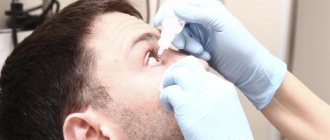What are foreign objects?
Foreign objects in children's noses can be of organic or inorganic origin.
In the first case, these are most often seeds, nuts, berries, candies, vitamins, as well as solid pieces of food - vegetables, fruits, crusts of bread, cookies. In addition, this includes various insects that can fly into the nose when a child is walking outside.
Items of inorganic origin are everything that a child may encounter at home or in kindergarten:
- beads, buttons, wheels from cars, small construction parts, cotton wool, pieces of paper, plasticine, small coins, buttons, paper clips, nails;
- fragments of nasal bones, glass, stones that ended up in the nasal cavity as a result of trauma to the nose and its sinuses.
As you understand from the composition of the material, the texture of its surface and the variety of shapes, foreign bodies are quite diverse.
According to the time of presence in the nasal cavity, foreign bodies are divided into:
- spicy. These are those that were recently (minutes, hours) introduced into the nasal cavity;
- chronic. These are those that are present in the nasal cavity for quite a long time (several days and months);
- rhinolitis. They are also called nose stones. They are formed due to the long-term presence of a foreign body in the nose. As a result, it becomes overgrown with connective tissue, which is formed due to damage to the mucous membrane by a foreign object and the development of inflammation.
In what cases do you need to urgently seek medical help?
You need a doctor's help if:
- You were unable to remove a foreign body from your nose yourself or were only able to remove part of it.
- A foreign body is dangerous. For example, it has sharp edges, or it is very shallow and can easily “sink” deeper.
- After a foreign body entered the nose, severe bleeding occurred.
- A foul-smelling liquid began to come out of my nose.
- There was difficulty breathing.
- You have removed the foreign body, but the nosebleed continues, which you cannot stop for more than 2-3 minutes.
- The foreign body is in both nostrils.
The doctor has special tools to help you safely remove the object from your nose. If the procedure is painful, the doctor will drop an anesthetic solution into the nose.
We will call you back, leave your phone number
Message sent!
expect a call, we will contact you shortly
Symptoms
Signs of the presence of acute foreign bodies in the nose are similar to the picture of acute rhinitis (runny nose).
Children complain about:
- itching in the nasal cavity (itching in the nose);
- difficulty breathing through the nose;
- frequent paroxysmal sneezing;
- copious watery discharge from the nose;
- bleeding, since if the nasal mucosa is damaged, there may be blood-streaked discharge or nosebleeds;
- pain in the nose when the mucous membrane is injured by a foreign object.
Adult patients almost always talk about when and what they put into their nose. Children are an exception. They are often afraid that they will be punished by their parents for their mischief, and keep silent about what happened. Therefore, it is important for parents to detect and remove a foreign body as soon as possible in order to avoid the development of complications.
If a foreign body gets into your nose: what can you do and what can’t you do?
First of all, it is important to know what you absolutely cannot do:
- Do not insert cotton swabs or other objects into your nose. This will only push the foreign body even deeper.
- Don't try to remove an item you can't see. Do not use tweezers or other tools. This may cause you to push the foreign body deeper or damage the nasal mucosa and cause bleeding.
- Don't breathe through your nose. Breathe through your mouth.
How to distinguish a normal runny nose from the presence of a foreign body in the nose?
If a child puts an object in his nose, some signs will help you understand that it is not a runny nose.
Signs of difference between a runny nose and a foreign body in the nasal cavity:
- If there is a foreign body, the process is usually one-sided, that is, it will itch and flow from only one nostril. With a runny nose, these signs are bilateral.
- Sudden onset. All signs appear suddenly against the background of the child’s complete health. If it is a runny nose, then children usually complain of feeling unwell (headache, drowsiness, body temperature rises).
If you think about the presence of a foreign body, but are not sure about it, be sure to show your child to the doctor. An extra examination will not harm the baby, but will help to avoid complications if there is a foreign body.
Chronic foreign bodies are clinically similar to chronic rhinitis or sinusitis (inflammation of the paranasal sinuses).
The child is worried about:
- difficulty breathing through the nose on one side;
- purulent or purulent-purulent (streaked with blood) nasal discharge with an unpleasant odor;
- inflammation of the nasal mucosa with the formation of purulent crusts.
Rhinolith is formed as a result of the long presence of a foreign body, due to which limited inflammation of the mucous membrane occurs, characterized by the proliferation of connective tissue and the deposition of salts, which ultimately ends with the foreign body becoming overgrown with the mucous membrane.
Children at this stage usually complain that they have difficulty breathing through their nose. Rhinoliths are often discovered by chance during routine examinations.
And now about the rules of first aid
If a foreign body “peeks out” from the nostril: You can try to pick it up with your fingers or some other tool and pull it out. But you need to act very carefully! If you are not sure that you can handle it yourself, it is better to consult a doctor!
If the foreign body is not visible: Press your finger on the healthy nostril and gently, with little effort, exhale air through the one in which the foreign body is located. You need to inhale through your mouth.
If these measures do not help, you will have to consult a doctor.
Ways of foreign bodies entering the nose
From the outside, that is, from the outside:
- children personally put something into their nose;
- some particles may end up in the nose as a result of medical manipulations (pieces of bandages, cotton wool);
- on the street, various small insects can fly into your nose;
- The baby may inhale fluff, particles of wool or pollen.
From inside:
- if a child chokes while eating and starts coughing, pieces of food enter the nasal cavity through the choanae;
- It happens that food particles get into the nose when the child vomits.
What should parents do?
What to do if you saw a baby sticking, for example, a seed up his nose?
Treatment of nasal diseases, including the removal of foreign bodies, is the task of an otorhinolaryngologist (ENT doctor).
If you see a foreign object or suspect that it may be in your child's nose, contact him. If this happens in the evening or on a weekend and the clinic is not open, you can go to the emergency room of the children's hospital.
Your child will be examined by the ENT doctor on duty, and if there is not one, then by the pediatrician on duty. The doctor will perform a rhinoscopy—examination of the nasal cavity using a nasal speculum—and, if possible, remove the foreign body. This procedure is completely painless.
Therefore, if your baby is over 2 years old, tell him about this so that he is not afraid and allows the doctor to examine himself calmly.
If a foreign body is not visible during rhinoscopy or the baby is very worried and does not allow himself to be examined, additional examination methods may be prescribed: ultrasound or radiography. But this happens quite rarely.
The child put a foreign object in his nose. What to do? detailed instructions
Many children love to put things up their noses. To find out whether a battery will fit there, or to find out whether a watermelon seed will sprout in their nose, is possible only with the help of such an experiment. And if children stuff objects into their noses for the sake of fun, then for parents it becomes real stress.
Should you immediately run to the doctor? Or try to get the item on your own? Our instructions will help you understand what to do.
Check your symptoms
If the child did not put an object in his nose right in front of you, then you will not know about it right away. You can tell that a child has a foreign object stuck in his nose based on several signs:
There is blood or clear fluid coming from the nose.
The child complains of pain around the nose.
The child smells smells that other people do not notice.
A whistling noise is heard while breathing.
This means that there must be some object stuck in the nostril! Headaches and bad breath may indicate that the object has been in the nose for a long time.
Do not panic
Try not to panic. Your panic will be passed on to the child, making it much more difficult to get the item. In addition, because of such a reaction, the child will definitely not confess to you in the future if something gets stuck in his nose again.
You most likely won't have to go to the hospital. Usually you can get objects out of your nose on your own, but it is important to act correctly.
Do not try to pick up the object with a cotton swab.
Nothing will work out for you, you will only push it further. You won’t be able to reach the object with your fingers for the same reason. Don't use dubious life hacks. For example, on forums they sometimes advise pulling out objects with a vacuum cleaner. But this is also dangerous.
Calm the child
Once you have dealt with your emotions, help your child calm down as well. Make sure he doesn't cry during the procedure - this will cause him to start sobbing. With each inhalation through the nose, the object will go deeper and deeper. Ask your child to breathe only through his mouth.
Examine the item
The next important step is to find out what exactly the child put up his nose. If your child refuses to tell you, do not put pressure on him or swear. Remember the rules from the previous paragraphs? No panic or tears!
Place your child in a chair and ask him to tilt his head forward. You may think that it is more convenient to place your baby on his back, but this is not the case. If he bends over, it will be easier for him to breathe. Sit in front of your child, try to look at the object and understand how deep it is.
Try the "Mommy's Kiss" technique
Of course, you should first kiss the child on the forehead to calm him down. But mom’s kiss will also help remove the object from the nose. This is the name for a simple but effective technique. It works best on small and hard objects. For example, beads.
Pinch your baby's free nostril with your finger. Press your lips to his mouth as if you are about to perform artificial respiration. Exhale air into the child's mouth slowly at first, and then exhale sharply. The video shows well how this method works.
View this post on Instagram
Posted by Find My Doula (@findmydoula)
It is not always possible to remove an item on the first try. Try again only when you are sure that the object in the nose does not threaten the baby's health.
Use tweezers
Remove large and soft objects (for example, lumps of cotton wool) that you can clearly see with tweezers. But this must be done very carefully. If it doesn’t work out the first time, it’s better not to continue, because there is a risk of pushing the object further.
Consult a doctor
You will have to go to the doctor if you cannot remove the object from your nose on your own. Don't put off going to the hospital when you can't even see an object.
You should immediately seek medical help if your child has a battery stuck in their nose. It is more dangerous than other objects, as it can cause burns to the mucous membrane.
After you remove the item, still go to the doctor. He will check to see if there are any parts or fragments left in the nose. And if necessary, he will prescribe drops or antibiotics, because objects can damage the mucous membrane and cause infection.
Hide other dangerous items
If this situation does not frighten the child too much, he will probably try to put another object up his nose later. Don't forget to tell him again that you can't do this. To be on the safe side, look around the house and remove other small items.
Read more on the topic
First aid for children: how to do CPR and how to react if a child is choking
Why batteries are dangerous: everything parents need to know
7 first aid courses for parents
Who are we and where can you read us?
After all, we have not only a website!
What can you do at home?
You can try to remove the foreign object yourself at home if it is nearby and you can see it clearly.
- Ask your child to blow his nose by pinching the empty nostril and tilting his head slightly forward.
- You can induce sneezing by letting your child smell pepper. When your baby sneezes, pinch the empty nostril closed.
- If you cannot remove the object, ask your baby to breathe through his mouth. This will prevent the item from going deeper. In this situation, you should consult a doctor without delay.
Children over five years old are allowed to try to remove a foreign body on their own when they understand you well and clearly follow your requests.
Never try to remove an object with your finger or using anything long and sharp. You can injure the mucous membrane or push it even deeper.
In cases where the baby is very anxious or has bleeding from his nose, removing a foreign object is risky due to the risk of complications. Therefore, you should not experiment, but you should go to an otolaryngologist.
What to do at home
But if it is not possible to remove the trapped objects in the hospital, then what to do in this case? How to remove a foreign object from a child's nose?
How to remove a foreign body from the nose yourself at home:
- It is necessary to remove the object from the child’s nasal cavity very carefully.
- Then you need to find out how deep the body got into the nose. To do this, you can take a regular flashlight and shine it into your sinuses.
- It is also important to find out what exactly children are putting up their noses. If it is an insect, then you urgently need to go to the doctor, as it can crawl further.
- Tell your child that foreign objects in the nose are very dangerous. Explain that the baby should inhale and exhale only through the mouth, so that the body does not fall deeper into the respiratory tract with a sigh.
- If the foreign object is not very large in size, then pulling it out is much easier. To remove a foreign body, you need to ask the child to blow his nose forcefully. At the same time, he should firmly press the nostril where there is nothing with his hand. When blowing your nose, you need to tilt your head forward.
- Before the baby starts blowing his nose, it is recommended to give him 2 drops of vasoconstrictor drugs. If you don’t have anything on hand, you can use ordinary vegetable oil. This will greatly simplify the process of removing the object from the nasal cavity.
- If the child is very small, he will not be able to blow his nose on his own. How to remove a foreign object in this case? You can do an enema. Use a rubber enema to blow air into a clean nostril. The child's mouth should be closed at this moment.
See also
Treatment of nasal polyps with folk remedies at home without surgery
Read
If any of the above methods fail to remove objects that fall inside the nasal cavity, then you should not be zealous.
You cannot try to remove the body in any possible way, otherwise the consequences could be disastrous.
When removing foreign bodies from the nasal cavity, you should not do the following:
- Try to pull it out with your hands (you can only push the body deeper into the spout);
- Rinse the sinuses with water;
- Even if the baby is very hungry or thirsty, under no circumstances should you give him food and water until the stuck body is removed;
- Trying to pull out the stuck item with tweezers (this can cause bleeding) or a cotton swab;
- Press on the nasal sinus where the foreign body is stuck with your fingers.
After removing objects, the nasal mucosa must be treated with antimicrobial agents. You cannot choose which medicine to use on your own. It is better to check this with your doctor.
Methods for removing foreign bodies from the nasal cavity in a medical facility
If a foreign body has recently entered the nose, the easiest way is to blow your nose intensively. If there is no effect, a solution of adrenaline or drops with a vasoconstrictor effect is sprayed into the nasal cavity and blown out again.
Removing a foreign body using tools.
Before removing it, children are anesthetized using a 10% lidocaine solution. Preschoolers may need anesthesia.
The instrument is selected depending on the characteristics of the foreign body. To remove a foreign body from a soft (cotton wool, paper, grass) or hard elongated (match) material, use tweezers. A round-shaped solid foreign body with a smooth surface is removed using a nose hook.
Surgery is required to remove rhinoliths, or in case of serious injury to the nose.
How to remove a foreign body from a child's nose
How to remove a foreign body from a child’s nose? Only a doctor can remove a foreign body from the nose. If you do it yourself at home, you can only make the situation worse. And then you will have to treat the child for various complications. For example, a baby may get sinusitis.
See also
Symptoms and signs of nasopharyngeal cancer, treatment methods, prevention, prognosis
Read
In particularly severe cases, surgery may be required. Not all children can easily tolerate surgery. Therefore, at the first sign of objects entering the sinuses, action must be taken to remove them.
An otolaryngologist can remove things that have gotten into the nose. If it is absent, you can contact a surgeon. You can also call an ambulance. In young children, the doctor performs endoscopic removal of foreign objects. It is produced with the help of painkillers. In some cases, even anesthesia may be required.
If you remove foreign bodies yourself, you still need to see a doctor. The otolaryngologist will examine the child and prescribe treatment to avoid contamination of the nasal mucosa with microbes or infection.











